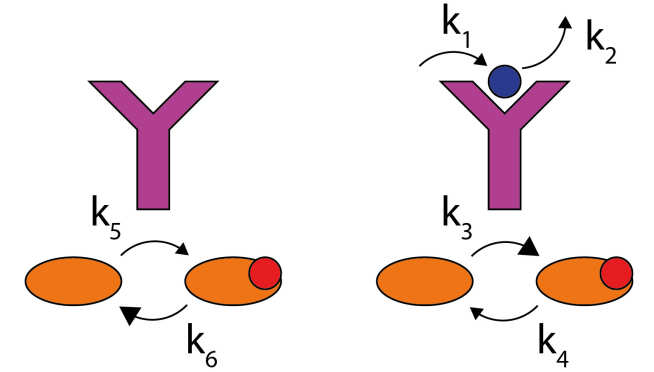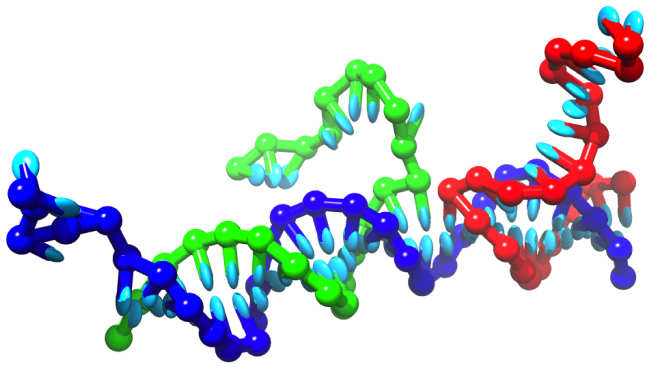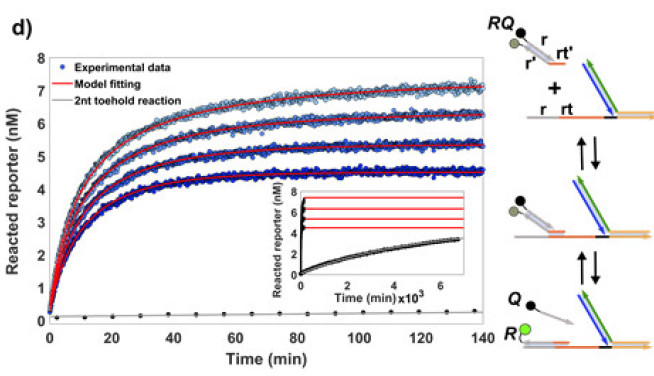Divert to blog, google scholar and OA
Topics
- Recent Highlights
- Functional molecular systems
- Coarse-grained modelling of DNA
- Thermodynamics of small systems
- Simulation tools and algorithms
- Biomolecular Engineering
We derive general thermodynamic bounds on information propagation in complex catalytic molecular templating networks. We thereby make rigorous a postulated link between stochastic thermodynamics and the crucial class of biochemical processes that determine cellular RNA and protein levels. In so doing, we make a fundamental discovery: information propagation in this context is limited by simple network properties. Moreover, optimal information processing involves a pseudo-equilibrium limit with negligible entropy production. These results shift the paradigm of molecular information processing, which has hitherto been assumed to require entropy production, and open up a new approach for engineering synthetic, low-cost information processing networks.
Backbone-assisted assembly processes -- such as protein folding -- allow the assembly of a large number of structures with high accuracy from only a small handful of fundamental building blocks. We aim to explore general principles underlying this phenomenon by studying variants of the temperature-1 abstract tile assembly model (aTAM). We consider the existence of finite sets of tile types that can deterministically assemble any shape producible by a given assembly model; we call such tile type sets universal assembly kits. Our first model, which we call the ``backboned aTAM", generates backbone-assisted assembly by forcing tiles to be be added to lattice positions neighbouring the immediately preceding tile, using a predetermined sequence of tile types. We demonstrate the existence of universal assembly kit for the backboned aTAM, and show that the existence of this set is maintained even under stringent restrictions to the rules of assembly. We hypothesise that the advantage of the backboned aTAM relative to the conventional aTAM -- which does not possess such a set -- is in part due to the specification of a sequence, and in part due to the geometric restrictions imposed by the backbone. To explore this intuition, we develop a second model call the ``sequenced aTAM". The sequenced aTAM uses a predetermined sequence of tiles, but does not constrain a tile to neighbour the immediately preceding tiles. We prove that this model has no universal assembly kit. The lack of such a kit is surprising, given that the number of tile sequences of length N scales faster than the number of producible shapes of size N for a sufficiently large -- but finite -- set of tiles.
Dec 2023: Exploiting bias in optimal finite-time copying protocols (submitted)
We study a finite-time cyclic copy protocol that creates persisting correlations between a memory and a data bit. The average work to copy the two states of the data bit consists of the mutual information created between the memory and data bit after copying, a cost due to the difference between the initial and final states of the memory bit, and a finite-time cost. At low copy speeds, the optimal initial distribution of the memory bit matches the bias in the expected outcome, set by the bias in the data bit and the copying accuracies. However, if both states of the data are copied with the same accuracy, then in the high-speed regime copying the unlikely data bit state becomes prohibitively costly with a biased memory; the optimal initial distribution is then pushed towards 50:50. Copying with unequal accuracies, at fixed copy-generated mutual information, yields an opposite yet more effective strategy. Here, the initial memory distribution becomes increasingly biased as the copy speed increases, drastically lowering the work and raising the maximum speed. This strategy is so effective that it induces a symmetry breaking transition for an unbiased data bit.
Nov 2023: Strong sequence dependence in RNA/DNA hybrid strand displacement kinetics (submitted)
Strand displacement reactions underlie dynamic nucleic acid nanotechnology. The kinetic and thermodynamic features of DNA-based displacement reactions are well understood and well predicted by current computational models. By contrast, understanding of RNA/DNA hybrid strand displacement kinetics is limited, restricting the design of increasingly complex RNA/DNA hybrid reaction networks with more tightly regulated dynamics. Given the importance of RNA as a diagnostic biomarker, and its critical role in intracellular processes, this shortfall is particularly limiting for the development of strand displacement-based therapeutics and diagnostics. Herein, we characterise 22 RNA/DNA hybrid strand displacement systems, systematically varying several common design parameters including toehold length and branch migration domain length. We observe the differences in stability between RNA-DNA hybrids and DNA-DNA duplexes have large effects on strand displacement rates, with rates for equivalent sequences differing by up to 3 orders of magnitude. Crucially, however, this effect is strongly sequence-dependent, with RNA invaders strongly favoured in a system with RNA strands of high purine content, and disfavoured in a system when the RNA strands have low purine content. These results lay the groundwork for more general design principles, allowing for creation of de novo reaction networks with novel complexity while maintaining predictable reaction kinetics.
Kinetic proofreading is used throughout natural systems to enhance the specificity of molecular recognition. At its most basic level, kinetic proofreading uses a supply of chemical fuel to drive a recognition interaction out of equilibrium, allowing a single free-energy difference between correct and incorrect targets to be exploited two or more times. Despite its importance in biology, there has been little effort to incorporate kinetic proofreading into synthetic systems in which molecular recognition is important, such as nucleic acid nanotechnology. In this letter, we introduce a DNA strand displacement-based kinetic proofreading motif, showing that the consumption of a DNA-based fuel can be used to enhance molecular recognition during a templated dimerization reaction. We then show that kinetic proofreading can enhance the specificity with which a probe discriminates single nucleotide mutations, both in terms of the initial rate with which the probe reacts and the long-time behaviour.
Information propagation by sequence-specific, template-catalyzed molecular assembly is the source of the biochemical complexity of living systems. Templating allows the production of thousands of sequence-defined proteins from only 20 distinct building blocks. By contrast, exploitation of this powerful chemical motif is rare in non-biological contexts, particularly in enzyme-free environments, where even the template-catalyzed formation of dimers is a significant challenge. The main obstacle is product inhibition: the tendency of products to bind to their templates more strongly than individual monomers, preventing the effective catalytic templating of longer polymers. Here we present a rationally designed enzyme-free system in which a DNA template catalyzes, with weak competitive product inhibition, the production of sequence-specific DNA dimers. We demonstrate the selective templating of 9 different dimers with high specificity and catalytic turnover. Most importantly, our mechanism demonstrates a rational design principle for engineering information propagation by molecular templating of longer polymers.
Dynamic DNA nanotechnology involves the use of DNA strands to create programmable reaction networks and nanodevices. The key reaction in dynamic DNA nanotechnology is the exchange of DNA strands between different molecular species, which is achieved through three‐way and four‐ way DNA exchange reactions. While both of these reactions have been widely used to build reaction circuits, the four‐way exchange reaction has traditionally been slower and less efficient than the three‐way reaction. In this paper, we describe a new mechanism to optimise the kinetics of the four‐ way DNA exchange reaction by adding bulges to the toeholds of the four‐way DNA complexes involved in the reaction. These bulges facilitate an alternative branch migration mechanism and destabilise the four‐way DNA junction, increasing the branch migration rate and unbinding rate of the four‐way exchange reaction, bringing it closer to the kinetics of the three‐way reaction. This new mechanism has the potential to expand the field of dynamic DNA nanotechnology by enabling efficient four‐way DNA exchange reactions for in vivo applications.


